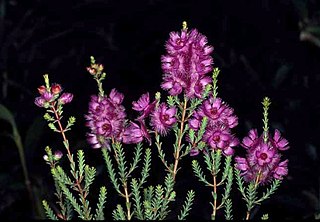
Chamelaucium, also known as waxflower, is a genus of shrubs endemic to south western Western Australia. They belong to the myrtle family Myrtaceae and have flowers similar to those of the tea-trees (Leptospermum). The most well-known species is the Geraldton wax, Chamelaucium uncinatum, which is cultivated widely for its large attractive flowers.

Banksia drummondii, commonly known as Drummond's dryandra, is a species of shrub that is endemic to Western Australia. It has pinnatifid to pinnatisect leaves, heads of up to one hundred cream-coloured, red and yellow flowers and glabrous fruit.

Acacia drummondii, commonly known as Drummond's wattle, is a perennial shrub endemic to Western Australia.
Verticordia attenuata is a flowering plant in the myrtle family, Myrtaceae and is endemic to the south-west of Western Australia. It is a shrub with a single main stem, small leaves and pink to purple flowers which fade to white as they age. It usually grows in sand in areas that are wet in winter, often amongst grasses and is found in coastal areas near Bunbury.

Grevillea drummondii, commonly known as Drummond's grevillea, is a species of flowering plant in the family Proteaceae and is endemic to the south-west of Western Australia. It is a low, spreading to erect shrub with narrowly elliptic to narrowly egg-shaped leaves with the narrower end towards the base, and dense groups of cream-coloured flowers that turn pink or red as they age.

Grevillea centristigma is a species of flowering plant in the family Proteaceae and is endemic to the south-west of Western Australia. It is a low, compact to erect, rounded or spreading shrub with softly-hairy narrowly elliptic to egg-shaped leaves with the narrower end towards the base, and deep yellow to orange flowers with a yellow, later brick-red style.

Lambertia inermis, Noongar chittick, is a shrub which is endemic to south-west Western Australia. It grows to 6 metres high and flowers from spring to winter. A more complete description is given in Florabase and Australian Flora online.

Eucalyptus drummondii, commonly known as Drummond's gum or Drummond's mallee, is a species of mallee or tree that is endemic to the southwest of Western Australia. It has smooth bark, narrow elliptical to egg-shaped adult leaves, flower buds in groups of seven, white flowers and hemispherical fruit.
Adenanthos cacomorphus is a small shrub in the family Proteaceae. It is found in southwest Western Australia.
Adenanthos dobagii, commonly known as Fitzgerald woollybush, is a shrub in the family Proteaceae. It grows to a mere 50 cm high, with crowded small silvery leaves and insignificant pink or cream flowers. It occurs only in southwestern Australia, where it is found in Fitzgerald River National Park on the south coast.

Eremophila drummondii, commonly known as Drummond's eremophila, is a flowering plant in the figwort family, Scrophulariaceae and is endemic to the south-west of Western Australia. It is a variable shrub, usually with sticky branches and leaves, long, thin leaves and mauve or purple flowers in spring.

Verticordia drummondii, commonly known as Drummond's featherflower, is a flowering plant in the myrtle family, Myrtaceae and is endemic to the south-west of Western Australia. It is an erect, openly to densely branched shrub with small, narrow leaves and pink to purple flowers in small heads near the ends of the branches.
Calytrix drummondii is a species of plant in the myrtle family Myrtaceae that is endemic to Western Australia.
Scholtzia drummondii is a shrub species in the family Myrtaceae that is endemic to Western Australia.

Petrophile drummondii is a species of flowering plant in the family Proteaceae and is endemic to southwestern Western Australia. It is a shrub with rigid, pinnate leaves with needle-shaped, sharply-pointed pinnae, and spherical heads of hairy, fragrant, yellow flowers.

Xanthorrhoea drummondii, commonly known as blackboy, grasstree or Drummond's balga, is a species of grasstree of the genus Xanthorrhoea native to Western Australia.
Phebalium drummondii is a species of small shrub that is endemic to Western Australia. It has smooth branchlets covered with silvery scales, broadly elliptic to egg-shaped leaves with silvery scales on the lower side and bright yellow flowers arranged in umbers on the ends of branchlets.
Goodenia drummondii is a species of flowering plant in the family Goodeniaceae and is endemic to the south-west of Western Australia. It is an erect shrub with linear to lance-shaped stem leaves, and spike-like thyrses of small white flowers with purplish spots.
Hibbertia drummondii is a shrub in the family Dilleniaceae family and is endemic to Western Australia. It is an erect shrub that typically grows to a height of 0.3–1 m. It flowers from September to October and produces yellow flowers. The species was first described in 1849 by Nikolai Turczaninow in the Bulletin de la Société Impériale des Naturalistes de Moscou and given the name Ochrolasia drummondii. In 1893, Ernest Friedrich Gilg changed the name to Hibbertia drummondii in Die Natürlichen Pflanzenfamilien. The specific epithet (drummondii) honours James Drummond.
Conostephium drummondii is a species of flowering plant in the family Ericaceae and is endemic to the south-west of Western Australia. It is a slender, erect or spreading shrub that typically grows to a height of 0.3–1.5 m. It is a variable species with multi-coloured flowers from March to July or from November to December.











